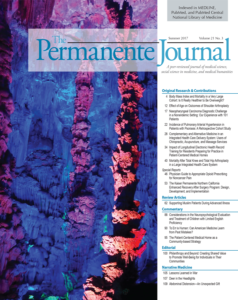Kaiser Permanente’s Department of Research and Evaluation in Southern California is 1 of 42 health systems selected to participate in a PCORI initiative.
Summer Edition of the Permanente Journal Now Available
 The latest Permanente Journal is now available for download, and includes a variety of peer-reviewed articles and studies on topics from total knee and hip anthroplasty to pulmonary arterial hypertension in patients with psoriasis. Learn more about Kaiser Permanente’s Northern California Enhanced Recovery After Surgery Program designed to reduce post-surgical morbidity and mortaility in a report co-written by Stephen Parodi, MD, associate executive director of The Permanente Medical Group, and read a physician’s guide to opioid prescribing for non-cancer pain written by Timothy Munzing, MD, the Family Medicine Residency Program director for Kaiser Permanente Orange County.
The latest Permanente Journal is now available for download, and includes a variety of peer-reviewed articles and studies on topics from total knee and hip anthroplasty to pulmonary arterial hypertension in patients with psoriasis. Learn more about Kaiser Permanente’s Northern California Enhanced Recovery After Surgery Program designed to reduce post-surgical morbidity and mortaility in a report co-written by Stephen Parodi, MD, associate executive director of The Permanente Medical Group, and read a physician’s guide to opioid prescribing for non-cancer pain written by Timothy Munzing, MD, the Family Medicine Residency Program director for Kaiser Permanente Orange County.
Read more about what’s inside this quarter’s Journal and click on articles of interest below. Or you can download the PDF for the complete edition.
Original Research & Contributions
![]() Body Mass Index and Mortality in a Very Large Cohort: Is It Really Healthier to Be Overweight?
Body Mass Index and Mortality in a Very Large Cohort: Is It Really Healthier to Be Overweight?
Arthur L Klatsky, MD; Jasmine Zhang; Natalia Udaltsova, PhD; Yan Li, MD, PhD; H Nicole Tran, MD, PhD
This retrospective cohort study in a multiracial population of 273,843 persons used logistic regression with 7 covariates (sex, age, race-ethnicity, education, marital status, smoking, alcohol intake). With average follow-up exceeding 30 years, there were 103,218 deaths: 41,215 attributed to cardiovascular causes and 62,003 to noncardiovascular causes. Compared with persons with body mass index defined as normal, persons who were underweight, overweight, and obese were at increased risk of death during a 30-year period.
Effect of Age on Outcomes of Shoulder Arthroplasty
Oke A Anakwenze, MD; Tameem Yehyawi, MD; Mark T Dillon, MD;Elizabeth Paxton, MA; Ronald Navarro, MD; Anshuman Singh, MD
In a retrospective cohort study of prospectively collected data, using an integrated health care system’s shoulder arthroplasty (SA) registry (1/2007-6/2012), patients were grouped into older (> 75 years) and younger groups (≤ 75 years). The total SA cohort had 2007 patients, 538 (27% > age 75 years), and the reverse total SA cohort had 568 patients, 295 (52%) age > 75 years. In the total SA cohort, older patients had higher risk of readmission and mortality. In the reverse total SA cohort, older patients had lower risk of revision.
![]() Nasopharyngeal Carcinoma Diagnostic Challenge in a Nonendemic Setting: Our Experience with 101 Patients
Nasopharyngeal Carcinoma Diagnostic Challenge in a Nonendemic Setting: Our Experience with 101 Patients
Kevin H Wang, MD; Stephanie A Austin, MD; Sonia H Chen, MD; David C Sonne, MD; Deepak Gurushanthaiah, MD
A retrospective chart review (2007-2010) included 101 patients; 70 were of Chinese or Southeast Asian descent. Median time from symptom onset to treatment was 6 months. One-third of cancers were missed with nasal endoscopy and imaging. An understanding of the risk factors, presenting symptoms, and limitations associated with these diagnostic tests is necessary to support earlier detection of this insidious cancer.
Incidence of Pulmonary Arterial Hypertension in Patients with Psoriasis: A Retrospective Cohort Study
Young M Choi, MD; Shannon Famenini, MD; Jashin J Wu, MD
Young M Choi, MD; Shannon Famenini, MD; Jashin J Wu, MD
In a retrospective cohort study (1/2004-11/2012), there were 10,115 patients with mild psoriasis, 3821 with severe psoriasis, and 69,360 matched controls. On multivariable analysis, there was a significantly increased risk of pulmonary arterial hypertension (PAH) developing in the severe psoriasis cohort vs their controls. The systemic inflammatory process underlying psoriasis may be a cause for an increased risk of PAH, but there are numerous secondary causes of PAH.
Complementary and Alternative Medicine in an Integrated Health Care Delivery System: Users of Chiropractic, Acupuncture, and Massage Services
Tracy McCubbin, MD; Karin L Kempe, MD, MPH; Arne Beck, PhD
From 2007-2014, 27,225 patients sought Center for Complementary Medicine (CCM) services (62% female, 73% white). Modalities included chiropractic (67%), acupuncture (18%), and massage (15%). Spine/truncal pain was most commonly reported (71%). Of patients, 59% saw their physician for their condition; 59% had not used CCM services previously; and 60% received medications for their condition. Mean ratings included pain relief with prior treatment (30%), current pain (4.33), and functional impairment ranging from 3.03 for relationships to 5.42 for enjoyment of life.
Impact of Longitudinal Electronic Health Record Training for Residents Preparing for Practice in Patient-Centered Medical Homes
Jung G Kim, MPH, CPH; Hector P Rodriguez, PhD, MPH; Katherine AT Estlin, MD; Carl G Morris, MD, MPH
Jung G Kim, MPH, CPH; Hector P Rodriguez, PhD, MPH; Katherine AT Estlin, MD; Carl G Morris, MD, MPH
The patient-centered medical home (PCMH) electronic health record (EHR) training consisted of case-based routine clinic visits delivered to 3 resident cohorts (N = 18). Participants (127) completed an EHR competency self-assessment (2011-2016). Comprehensive training designed to improve EHR competencies for practicing in a PCMH resulted in improved assessment scores. Findings indicate EHR training as part of resident exposure to the PCMH measurably improves self-assessed competencies, even among residents less engaged in EHR training.
Mortality After Total Knee and Total Hip Arthroplasty in a Large Integrated Health Care System
Maria C S Inacio, PhD; Mark T Dillon, MD; Alex Miric, MD; Ronald A Navarro, MD; Elizabeth W Paxton, MA
In a retrospective analysis of an integrated health care system population in 2010, 10,163 primary total knee arthroplasties (TKAs), 4963 primary total hip arthroplasties (THAs), 606 revision TKAs, and 496 revision THAs were evaluated. Patients undergoing primary THA and TKA had lower odds of mortality than expected. Patients with revision TKA had higher-than-expected mortality odds, whereas patients with revision THA did not have higher-than-expected odds of mortality.
Special Report
![]() Physician Guide to Appropriate Opioid Prescribing for Noncancer Pain
Physician Guide to Appropriate Opioid Prescribing for Noncancer Pain
Timothy Munzing, MD, FAAFP
The author highlights key topics in the management of patients using opioids (or potentially needing opioids) in outpatient clinical practice; federal and state law enforcement actions regarding physicians’ illegal prescribing of opioids; multimodal approaches to pain control; nonmedication management of pain; response strategies when suspecting a patient of diverting or misusing opioids; and warning signs for abuse or diversion. In addition to individual action, the initiation of systemwide and clinicwide safe prescribing practices supports the physician and patient such that the patient’s well-being is at the heart of all pain management decisions.
Special Report
The Kaiser Permanente Northern California Enhanced Recovery After Surgery Program: Design, Development, and Implementation
Vincent X Liu, MD, MS; Efren Rosas, MD; Judith C Hwang, MD, MBA; Eric Cain, MD, MBA; Anne Foss-Durant, RN, MSN, FNP, MBA; Molly Clopp, RN, MS, MBA; Mengfei Huang, MSc; Alexander Mustille; Vivian M Reyes, MD; Shirley S Paulson DNP(c), MPA, RN, NEA-BC; Michelle Caughey, MD; Stephen Parodi, MD
In this report, the authors describe the design, development, and implementation of an Enhanced Recovery After Surgery program in the Kaiser Permanente Northern California integrated health care delivery system (2014), targeting patients with elective colorectal resection and those with emergent hip fracture repair across 20 Medical Centers. The program leveraged multidisciplinary and broad-based leadership, high-quality data and analytic infrastructure, patient-centered education, and regional-local mentorship alignment. This program has already had an impact on more than 17,000 patients.
Review Articles
![]() Supporting Muslim Patients During Advanced Illness
Supporting Muslim Patients During Advanced Illness
Nathan A Boucher, DrPH, PA-C, MS, MPA, CPHQ; Ejaz A Siddiqui, MIS; Harold G Koenig, MD, MHS
Worldwide violence perpetrated by people identifying as Muslim has been a growing fear for people living in the US and elsewhere. This article explores conditions needed for prayer, roles of medical treatment and religious authority, modesty, and the role of family in making medical decisions. Initial recommendations are provided to optimize care for Muslim patients and their families, informed by the described tenets of Muslim faith.
Clinical Medicine
Use of a Technetium99m-Sestamibi Scan to Detect Ipsilateral Double Adenoma in a Patient with Primary Hyperparathyroidism: A Case Report
Joseph Gabriel Gabriel, MD; Alejandro Contreras, MD; Andrew Rosenthal, MD
Patients with primary hyperparathyroidism generally have a single parathyroid adenoma that causes excessive excretion of parathyroid hormone. About 2% to 15% of these patients have a double adenoma. Presurgical imaging and nuclear scans can help to localize multiple lesions, and intraoperative parathyroid hormone assays can confirm the diagnosis and cure.
A Clinical Approach to Animal Bites with an Avulsion Flap: A Case Report
Andrew Williamson, MD; Cyril Thomas, MS, PA-C
A 90-year-old white woman sustained a large dog bite to her hand, over the dorsal aspect of the first metacarpal, which was repaired with the avulsion flap as a biologic dressing that employed a perforating technique to successfully treat the wound and allow for optimal wound healing. Photographs at several stages are included.
Splenic Abscess in Immunocompetent Patients Managed Primarily without Splenectomy: A Series of 7 Cases
S Divyashree, MBBS, MD; Nikhil Gupta, MBBS, MD
A microbiological diagnosis of splenic abscess is of utmost importance. In this case series, all patients underwent percutaneous aspiration. This was performed under radiologic guidance (either ultrasonography or computed tomography). Only one patient required diagnostic splenectomy. Appropriate antibiotic therapy is the cornerstone of management.
Flood Syndrome: Spontaneous Umbilical Hernia Rupture Leaking Ascitic Fluid-A Case Report
Emilie T Nguyen, MD; Leah A Tudtud-Hans, MD
The spontaneous rupture of an umbilical hernia in a 42-year-old man with hepatitis C and alcoholic cirrhosis was complicated by ascites and esophageal varices. This is a rare complication with high mortality rates and stresses the challenge of treatment that falls in the area between medical and surgical management.
Dinesh Atwal, MD; Krishna P Joshi, MD; Rahul Ravilla, MD; Fade Mahmoud, MD
Roxana Covali, MD, PhD; Lucian Ambrosie, MD; Micea Onofriescu, MD, PhD; Alexandru Luca, MD, PhD; Gabriela Dumachita-Sargu, MD, PhD; Violeta Aursulesei, MD; Dumitru Gafitanu, MD, PhD
Dinesh Atwal, MD; Krishna Prasad Joshi, MD; Susanne Jeffus, MD; James Ntambi, MD; Fade Mahmoud, MD, FACP
Image Diagnosis: Multivessel Percutaneous Coronary Intervention in Dextrocardia: Success with Usual Techniques in a Case of Mirror-Image Heart
Mohamed Morsy, MD; Pranab Das, MD; Inyong Hwang, MD; Rami N Khouzam, MD, FACC, FACP, FASNC, FASE, FSCAI
Although dextrocardia is very rare, it could be clinically noted in a variety of cardiovascular and noncardiovascular conditions. Patients with dextrocardia can have various clinical presentations, including acute coronary syndrome and congestive heart failure. Successful diagnostic catheterization and multivessel intervention can be achieved through conventional catheters with appropriate reversed rotation and without need for right/left reversal of radiologic views.
Image Diagnosis: A Gastric Signet-Ring Adenocarcinoma of Type Linitis Plastica Mimicking Splenomegaly in a Patient with Chronic Lymphocytic Leukemia
Leonid L Yavorkovsky, MD, PhD; Shazia Ali, MD
Typically, adenocarcinoma of type linitis plastica, known as Brinton disease or leather bottle stomach, is characterized by diffuse infiltration of neoplastic signet-ring cells. This imparts a rigid consistency to the stomach wall, with a thickened, fibrotic appearance. These symptoms in this patient mimicked the appearance of an enlarged spleen.
Image Diagnosis: Rapidly Enlarging Scrotal Hematoma: A Complication of Femoral Access?
Alonso Cardenas, MD; Laura Villavicencio, MD, MS; Mani Pavuluri, MD, PhD
Diagnosis of retroperitoneal bleeding is made with abdominopelvic computed tomography. Ultrasound or computed tomography can provide the diagnosis for scrotal hematoma. Treatment of scrotal hematoma has ranged from conservative measures, including scrotal elevation and resuscitation with IV crystalloids or blood products, to open surgical options.
Image Diagnosis: Iliopsoas Abscess from Crohn Disease
Ashley S Abraham; Michelle Y Liu; David R Vinson, MD
Crohn disease is a common cause of secondary iliopsoas abscesses, occurring in an estimated 0.4% to 4.3% of patients. Although long-term corticosteroid use with its attendant immunosuppression could increase the risk for abscess formation, a short course is unlikely to have the same effect.
Ashok Shah, MD; Shekhar Kunal, MBBS
![]() Image Diagnosis: Carcinoid Tumorlets and Pulmonary Sequestration in a Patient With Chronic Cough Without a History of Malignancy
Image Diagnosis: Carcinoid Tumorlets and Pulmonary Sequestration in a Patient With Chronic Cough Without a History of Malignancy
Zhou Zhang, MD; Harleen Hayreh, MD
Commentary
Considerations in the Neuropsychological Evaluation and Treatment of Children with Limited English Proficiency
Alonso Cardenas, MD; Laura Villavicencio, MD, MS; Mani Pavuluri, MD, PhD
Given the large number of Spanish speakers in the US, the authors illustrate, with a case example, the need to test students in their native language especially when the second language has not yet been mastered. Accurate assessment of the brain’s potential may yield enhanced opportunities and optimize expectations, rather than undervaluing a developing child’s elastic brain maturation.
To Err is Human: Can American Medicine Learn from Past Mistakes?
Jeffrey B Ritterman, MD
The history of medicine includes many errors. Some persisted for decades and caused great harm. Several are highlighted in this article, including the mythical thymic diseases: thymic asthma and status thymicolymphaticus. Some medical mistakes, such as the diet-heart hypothesis of Ancel Keys, continue to cause harm. To avoid future errors and their associated harm, the author suggests a cultural shift encouraging professional humility and greater questioning of medical dogma. Medical education focused on teaching students this history may help with this cultural shift.
The Patient-Centered Medical Home as a Community-based Strategy
Berkeley A Franz, PhD; John W Murphy, PhD
Although patient perspectives are critical to the patient-centered medical home (PCMH), this article questions whether the PCMH in practice is truly community-based. That is, do physicians, planners, and other health care professionals take seriously the value of integrating local knowledge into medical care? The argument presented is that community-based philosophy contains a foundational principle that the perspectives of health care practitioners and community members must be integrated.
Editorial
Philanthropy and Beyond: Creating Shared Value to Promote Well-Being for Individuals in Their Communities
Thomas E Kottke, MD, MSPH; Nico Pronk, PhD, MA; Andrew R Zinkel, MD, MBA; George J Isham, MD, MS
Health care organizations can magnify the impact of their community service and other philanthropic activities by implementing programs that create shared value. The author uses three initiatives in sectors other than health care to illustrate the concept of shared value, and also presents examples of shared value programs sponsored by health care organizations: telehealth, worksite health promotion, school-based health centers, green and healthy housing, and clean and green health services.
Narrative Medicine
Lessons Learned in War
Alberto Hayek, MDIn civilian life one does not encounter these kinds of experiences, but the pain of a family with an ill child confronting a fatal prognosis is akin to a missile sent from an unknown source. As a physician, these painful experiences haunt me when all I can do is to be a silent participant while sharing the pain of unavoidable death.
Alberto Hayek, MDIn civilian life one does not encounter these kinds of experiences, but the pain of a family with an ill child confronting a fatal prognosis is akin to a missile sent from an unknown source. As a physician, these painful experiences haunt me when all I can do is to be a silent participant while sharing the pain of unavoidable death.
Deer in the Headlights
Tom Paluch, MD
“I just don’t know,” I respond flatly. The profundity of those four words is not lost on her. Her eyes widen like those of a deer in the headlights on a lonely country road late at night, frozen by the oncoming, unknown terror, unable to run, waiting to see if this thing, this rushing menace will stop, or sweep it away.
Abdominal Distension-An Unexpected Gift
Ching Soong Khoo, MD, MRCP (UK)
“That is a baby!” I swiftly showed her the fetal heartbeats on the scan. Her eyes immediately welled up with tears of joy-relieved that the swelling in her tummy wasn’t something more sinister. Being underprivileged with limited access to health care services, she had felt helpless and frightened by her abdominal distension.
Book Reviews
Prenatal Development and Parents’ Lived Experiences: How Early Events Shape Our Psychophysiology and Relationships by Ann Diamond Weinstein
Review by Anna Luise Kirkengen, MD, PhD
Review by Anna Luise Kirkengen, MD, PhD

